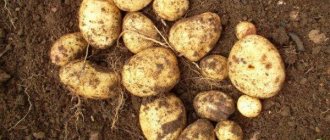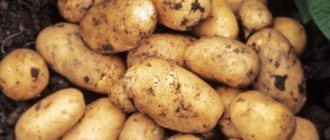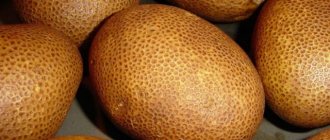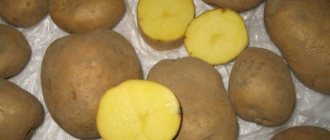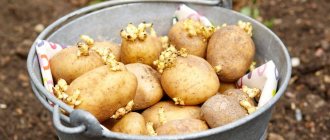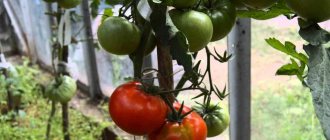Granada potatoes are mid-early table varieties. It was created by German scientists from the famous. The variety is young, especially on the Russian market. Granada was withdrawn at the end of 2014. It entered the State Register of the Russian Federation only in 2021.
Granada is recommended for cultivation in the Middle Volga region, but in such a short period of time it has managed to fall in love with residents of other regions of the country.
Today Granada is considered one of the best potato varieties in Europe.
In the publication you will get acquainted with the characteristics of Granada, with its photos and reviews.
Variety of potato varieties
It is the opportunity to choose that makes this culture very popular. First, you should know that potatoes are divided according to yield and ripening time:
- Early varieties. The difference between this group and other species is its rapid growth and short growing season. Planting of these potato varieties begins in early spring. Already at the beginning of April, the first tubers fall into the ground, and after 65 (on average) days the crop is ready for harvest. In the vacant space in the garden, you can plant another crop, which will have time to produce a new harvest before the fall. The disadvantage of early potatoes is their inability to be stored. It will not lie down for a long time and will quickly become lethargic - it loses moisture.
- Mid-early varieties. They are considered more unpretentious and capable of storage. Tubers of such potatoes must be prepared for planting (germinated). The harvest is obtained a little later than the early varieties - after 80 days.
- Mid-season varieties. Most often, the choice of gardeners falls on these types of potatoes. The harvest is ready for harvest in 90-100 days. This period usually falls in August. They are considered less whimsical, with good taste.
- Mid-late and late varieties. The most suitable varieties for long-term storage, which provide delicious vegetables throughout the winter. The tubers do not need to be germinated; the varieties are more resistant to diseases and unfavorable conditions. The harvest ripens in 110-120 days.
Mid-early and mid-late varieties are classified as intermediate potato varieties. The high content of starch, vitamins and protein makes potatoes indispensable in the diet. If a variety is needed for winter consumption, then among the qualities that the tubers possess should be:
- good keeping quality;
- long period of rest;
- resistance to storage diseases.
It is quite difficult to find a variety that fully meets all requirements. But still, breeders are trying to develop potato brands that best meet the needs of vegetable growers. Among such reliable varieties, Granada potatoes should be noted.
Chrysanthemum Korean
This is the common name of a group of perennial small-flowered varieties of hybrid origin, part of the Garden Chrysanthemum species. Varieties of this group are able to withstand low temperatures.
Chrysanthemum Aurora
The bush grows up to 70 cm. It has a columnar shape, a few powerful shoots and double inflorescences. The upper side of the reed flowers is colored red, the lower side is yellow. Flowering occurs in September and is not abundant.
Chrysanthemum Flamingo Pink
The plant is winter-hardy and drought-resistant. The maximum height of the bush is 65 cm. The peduncle is strong, the leaves are leathery, of medium size. The inflorescence is corymbose, double, light pink, reaches 8 cm in diameter. Flowering is abundant, from late September to late October.
Chrysanthemum Apple Blossom
The bush grows up to 55 cm and has many shoots. Inflorescences up to 10 cm in diameter. The flower is white-pink, double, reaching 8 cm in diameter. Blooms profusely in September-October. Towards the end of flowering it becomes white.
Garden chrysanthemums are also divided into several classes, depending on the type of inflorescences: spherical, double, semi-double, curly, rayed, pompom and others. Each class includes a large number of varieties. Belonging to a certain class does not negate its belonging to one of the species described above. Thus, the Aurora, Pink Flamingo and Apple blossom chrysanthemums have a double type of inflorescence.
Description and features
If we start describing the Granada variety with its appearance, we will need to note the attractiveness of the tubers.
They are medium in size and have a beautiful oval-oblong shape. The weight of each Granada potato ranges around 100 g, so all the tubers look very neat due to their almost identical size. The eyes are harmoniously located over the entire surface of the skin, without disturbing the attractiveness of the tubers. This gives Granada potatoes a high-quality presentation. Therefore, the variety attracts the attention of not only summer residents, but also farmers who grow potatoes for sale. The color of the peel and pulp is light yellow. When damaged and after heat treatment, tubers of the Granada variety do not change their color or darken. This is another significant plus for buyers.
The taste qualities of the Granada variety are very high. The skin is thin, smooth, but durable. The pulp is tender and pleasant to the taste. Granada potatoes are used to prepare culinary delicacies and are recommended for the diet. In terms of its nutritional composition, it has a high starch content (over 17%), which makes the tubers pleasant to the taste.
Attention! They do not boil over and retain their shape, so they are suitable for making salads and casseroles.
The Granada variety, whose yield characteristics are very high, is in deserved demand. After all, up to 15 potatoes are harvested from one mature bush. This species is a mid-late species, so the harvest is harvested 110 days after planting. The yield of Granada potatoes is more than 6.5 kg per 1 sq. m of plot area, which makes it possible to grow only this variety without duplicating others.
Keeping quality or storage ability is always considered an important quality for potatoes. No appearance will save the harvest if the tubers rot or dry out in winter. The Granada variety meets all the expectations of vegetable growers. Keeping quality is a record – 97%. Material waste after winter storage averages 3%. Breeders took into account all the requests of potato growers when developing the Granada variety.
The bush of the plant is classified as an intermediate type, the height of one is in the average range. The bulk is quite low, but some plants can grow to medium size. The leaf mass is light green, small.
Important! The size of the Granada potato bush directly depends on the type of soil, its fertility and climatic conditions.
Another important quality that the Granada variety has is drought resistance. In addition, these potatoes grow well in any soil. If all these advantages have attracted your attention, then it’s worth taking a closer look at the agricultural technology of growing wonderful potatoes.
Characteristics of Granada potatoes
According to the stated characteristics, the Granada potato variety is hardy, productive, and resistant to diseases. Its shelf life is good, more than 95%. For six months, potatoes retain 85% of their marketable appearance. The variety is well transported over long distances and is suitable for industrial cultivation.
Productivity
Yield indicators depend on soil type and may vary in different regions. They are higher in sandy soil. The average stable figure is 6 kg/sq. m. This is 1.5 times more than the famous Sineglazka variety. Today, in the yield table, Granada is in first place.
| Potato variety | Yield indicators |
| Granada | 6.0 kg/sq. m |
| Tuleevsky | up to 5.0 kg/sq. m |
| Kolobok | up to 4.5 kg/sq. m |
| Sineglazka | 4.5–5 kg/sq. m |
| Laura | 3.5 kg/sq. m |
Resistance to diseases and pests
Bushes have good immunity from the following diseases:
- scab;
- potato cancer;
- late blight;
- rotting of tubers.
However, the Granada potato variety is prone to Fusarium wilt. The photo shows all the signs of the disease.
Fusarium spreads quickly and can destroy 50% of the crop. At first, the leaves acquire an unhealthy light shade, then the stems gradually become brown. The plant is rapidly withering. Only comprehensive measures will help to cope with the disease:
- Promptly remove all affected plants.
- Treat tubers before planting.
- Maintain crop rotation.
If you need to get a large harvest of potatoes, you cannot grow them in the same place. Legumes, cabbage, cucumbers, pumpkins, and root vegetables will be good precursors to the crop. Before planting, the tubers are treated with a solution of the drugs “Maxim”, “Fitosporin”, “Baktofit”.
According to the description, the most dangerous pests for Granada potatoes are the Colorado potato beetle and wireworm. To combat them, acceptable drugs are used.
An infusion of tobacco or wormwood will help get rid of the beetle. Take 300 g of crushed wormwood for 10 liters of water, boil and leave for 3 hours. Then strain the broth and treat the bushes.
Important! Onion peels, which are placed in a hole with potatoes, will repel the wireworm.
Advantages and disadvantages of the variety
Granada potatoes compete with many well-known varieties. It has many positive characteristics, which are listed in the table below.
| Advantages of the variety | Disadvantages of the variety |
| Stable yield | The need for frequent feeding |
| Compact bush size | Susceptibility to Fusarium |
| Drought resistance | |
| Ability to preserve varietal characteristics | |
| High preservation of tubers during storage | |
| Excellent taste of potatoes | |
| Good immunity | |
| Presentation of tubers | |
| Possibility of transportation |
Responsible moment - getting ready to land
Experienced potato growers begin preparing for planting in the fall. As soon as the crop is collected and sorted, you need to begin selecting seed material. For planting, you need to choose large, healthy tubers of the Granada variety that can produce good sprouts. Many gardeners believe that they should take small potatoes for planting, but this can lead to a significant reduction in yield and loss of valuable qualities of the variety. For the Granada potato variety, an important requirement remains the selection of large, good tubers from full-fledged bushes for the new planting year. In the spring, according to the recommendations of experts, you can do two things:
- plant seed immediately in open ground;
- grow seedlings, which increases yield by 40%.
In the first option, Granada tubers are planted, focusing on the recommendations of the lunar sowing calendar. But many gardeners simply stick to the usual deadlines and begin planting Granada potatoes at the end of April. If the soil is not warm enough, planting is postponed for a week or more. This depends on the climate of the region and soil temperature. It should not be lower than +8°C.
For the second option, first place the tubers for germination in a mixture of peat and soil and cover them. When the sprouts appear, they are broken off and placed in boxes with prepared soil. It should contain garden soil, peat and sand. They take 4 times more peat than land. The amount of sand depends on the composition of the garden soil. The sprouts must be buried 2/3 deep and watered as the soil dries. The box is placed so that the illumination is very good and covered with film. The first shoots usually appear after 18 days. After another 14 days they are ready to be disembarked for permanent residence.
The method of planting Granada seed potatoes depends on the type of soil and weather conditions in the growing region. The dry, hot climate and light soil allow tubers to be planted in holes or furrows. In more damp and dense soil, ridges are made to raise the bushes above the ground. Clay soil requires a planting depth of no more than 5 cm, but with loose and fertile soil the depth reaches 12 cm.
The optimal row spacing is 65-70 cm. This row arrangement will allow the Granada potato bushes to have good lighting and air access. A distance of at least 30 cm is maintained between plants. When planting, the soil is fertilized with ash. Add half a glass of ash to each hole and be sure to moisten the soil. Then put the potatoes and sprinkle with soil. If there is not enough ash or no ash at all, then you can replenish it with mineral complex fertilizers according to the instructions.
Important! When planting Granada potatoes, using fresh manure is strictly prohibited! This can lead to the death of the seed material.
Correct fit
Proper planting begins with pre-sowing activities:
- Site preparation. The “rested” land that has come out of crop rotation is cleared of weeds in advance using systemic herbicides: “Zenkor”, “Lazurit”. Shortly before planting, the soil must be loosened to a depth of 15 cm;
- Seed sorting. Large tubers are selected for planting from the strongest bushes, which are planned even before harvesting. Of the large ones, only whole, healthy, uniformly colored ones are taken for planting;
- Germination. 2-3 weeks before planting, planting material is placed in wooden boxes, sprinkled with peat, covered with film and taken out to a bright place with a temperature of 10-14*C;
- Treatment. Immediately before planting in the ground, the sprouted tubers are soaked in weak potassium permanganate or treated with disinfectants such as Prestige or Taran. Disinfection protects fruits from soil pests and increases overall germination to 90-100%;
- Before planting potatoes in the ground, the planting holes are fertilized with ash, humus, and sprinkled with eggshells.
Planting Density
The distance between bushes should be about 30-40 cm. The standard row spacing is 70-75 cm. Planting depth varies depending on the soil: from 12-15 cm on sandy soils to 5-8 cm on heavy loam.
“Granada” is productive:
Boarding time
Planting is carried out in soil heated to 8*C: in the south - in mid-late April, in the central and northern regions - in early-mid May.
"Granada" does not require maintenance. High yields can be achieved using conventional agricultural techniques:
Hilling. During the season it is necessary to perform it twice: When the shoots grow to 10-15 cm; At the budding phase.
Loosening. The soil begins to be loosened from the moment the seedlings appear, and is completed immediately before harvesting. In dry weather, loosening is reduced to breaking the dry earthen crust and is performed no more than once a week;
Watering
You can irrigate potatoes in any available way, it is only important to follow the basic rules: Watering should be deep - from 50 cm into the ground; When watering, water should not fall on the tops of plants, especially during the daytime. It is best to irrigate the soil in the evening, filling the rows with a hose or pouring water directly under the bush (at least 1 bucket for each plant.
Mulching
To retain moisture in the ground and protect the soil from drying out, the row spacing is tightly covered with a layer of straw up to 20 cm. An additional positive effect of mulch is to inhibit the growth of weeds.
Souvenir Chernigov, Roko, Kuras, Granada:
Top dressing
During the season, 2 feedings are carried out:
- A month after landing. Potassium sulfate and diluted droppings are added to the soil;
- At the budding stage, they are fed with superphosphate and saltpeter.
Basic care requirements
The main stages of agricultural technology remain the same as for other varieties. Potatoes "Granada" are unpretentious varieties with a high degree of drought resistance and adaptability to growing conditions. The main stages of high-quality care for the Granada variety:
- Hilling. Until the Granada potatoes reach their ripeness, it is necessary to carry out this procedure at least twice. The first is when the height of the bush is 15-16 cm, the second - before flowering begins. To do this, use the soil between the rows, raking it to the base of the bushes. It is not recommended to skip this step for several reasons. Firstly, hilling will allow you to form a neat bush and prevent it from falling apart. Secondly, it will improve the yield of Granada potatoes due to the formation of additional underground stems, Thirdly, it will protect the seedlings from possible frosts.
- Nutrition. The first time you should feed potatoes is after planting, a month later. Use a mixture of mineral fertilizers: urea, potassium sulfate and superphosphate in a ratio of 1:1:2. Where 1 is 10 g, respectively, 2 is 20 g. This amount should be taken per 10 liters of water. If more is needed, then increase the amount of minerals. The mixture is diluted and watered over the potatoes. Organic is an excellent option. Granada potatoes respond very well to bird droppings. The main thing is to use it correctly so as not to burn the plants. The droppings are infused for at least a week, diluted with 0.5 liters in a bucket of water and watered over the potatoes. The plants are fed the second time when the buds appear, the third time after flowering.
- Watering.
For the Granada variety, you need to maintain moderate watering. Under normal climatic conditions, watering should be carried out no more than three times per season - after emergence, after budding, after flowering. In rainy weather, you may not need to water at all until flowering. Watering is considered to be of high quality if the soil is wet to 50 cm.
- Prevention, control of diseases and pests. For the Granada variety, there is a danger of Alternaria blight, which affects all plant structures.
To prevent such a disaster, tubers are sprayed before planting. Biological products “Baktofit”, “Integral”, “Planriz” are suitable for prevention. The vegetative period requires treatment with a 0.2% solution of other drugs - “Profit”, “Kuproksat”, “Tanos”. To prevent Fusarium wilt of Granada potatoes, it is best to use Baktofit or Fitosporin.
These drugs must also be used during pre-sowing treatment. If this is not done, then the entire harvest will be at risk. This infection is very dangerous for Granada potatoes due to its rapid spread. During the period of illness, it is very difficult to save plants. Preventative treatments should also be done against different types of potato rot.
Among pests, the Colorado potato beetle is considered the most dangerous. The damage this pest causes is most noticeable. Also, click beetle larvae are dangerous. They are called wireworms. Measures to combat these pests are similar for all crops that are exposed to them.
With due attention to the variety, “Granada” will reward you with an unprecedented harvest.
Diseases and pests
Granada is not the most protected variety. When growing it, you may encounter pests and diseases such as:
- Alternaria blight.
- Fusarium.
- Brown bacterial rot.
- Ring rot.
- Colorado beetle.
- Wireworm.
Alternaria blight
When infested, this fungus affects stems, leaves and roots. 15 days before flowering begins, dark spots appear on the infected bush. As the disease spreads, leaves turn yellow and fall off.
To treat this disease, special chemistry such as Agat-25 or Planriz is used.
Fusarium
Most often, the disease is active during the flowering period of the bush. When infested with fusarium, the plant changes its color. The leaves become lighter, the stems turn brown. 3-4 days after infection, the culture begins to die.
Fusarium is prevented with fungicides such as Baktofit or Fitosporin. Planting material is treated with these preparations.
Brown bacterial rot
When infected with this disease, the leaves begin to turn yellow and wither. To prevent rot from affecting the crop in the future, planting material is treated with TMDT.
Ring rot
Affects the entire plant. Ring rot is characterized by rapid spread of the disease. If the disease is not prevented in time, it can take up to 45% of the harvest. As in the previous case, TMDT is used to prevent invasion by this disease.
We recommend reading: “Description of the potato variety Madeline (Madeline)”
Colorado beetles
The Colorado potato beetle is Granada's enemy number 1. It is unlikely that it will be possible to protect the bushes from an attack by a “foreign guest”. If the bushes are attacked by Colorado potato beetles, then measures must be taken immediately. You can collect the larvae, adults and eggs in the old-fashioned way and drown them in a soapy solution. Or use modern insecticides.
Wireworm
To protect the crop from these parasites, it is necessary to dig up the soil every year. Also, remove weeds, as the larvae like to accumulate near them in large numbers.
We receive a well-deserved reward
Harvest is always a special time for farmers. This is the time to get the result.
Granada potatoes are ready for harvest 3.5-4 months after planting. During manual harvesting, the bush is dug up with a shovel and the tubers are collected. The process of sorting potatoes should not be neglected. You can immediately select the best seed material for next year and choose potatoes for winter storage. To better preserve potatoes, they are sprayed. Prepare a solution of copper sulfate (2g per 10l) and treat all tubers. Granada seed potatoes and food potatoes are stored separately. Provide a dry, cool and dark environment. The optimal temperature is from +2 to +4°C. Tubers are periodically inspected to remove spoiled ones so that the rest of the crop is not damaged.
Harvest and storage
Depending on the timing of planting, the harvest is harvested in mid-to-late August. Carefully bury the shovel under the bush to the length of a bayonet and pry up the tubers. If the soil is wet during harvesting, the tubers are left to dry between the rows, after which it is easier to shake off the remaining soil from them.
Tubers selected for seeds are left for landscaping. In rainy weather - under a canopy, in dry weather - under the sun. The duration of the process is 10–12 days. During this time, the tubers will be filled with solanine, which will protect them from diseases and pests.
After drying and clearing the soil, table potatoes are stored in a cellar, dry, ventilated at a temperature of +2...+4°C. Granada can be stored for more than six months without loss of taste. Vegetables are periodically inspected and spoiled ones are removed.
Granada is a high-quality potato variety worthy of the attention of both large farms and summer residents. All you need to grow a wonderful harvest without difficulty is compliance with crop rotation and agricultural technology.
Reviews from experts
Tatyana Vasilievna German, agronomist, Astrakhan
On our farm, German and Dutch potato varieties have been selected for cultivation. Among them is Granada. This variety has not yet been certified, so it is under close attention. The productivity is extraordinary. I think the prospects for this variety are the most positive.
Anton Varyagin, farmer, Bodaibo
The “Granada” variety was planted on our farm for the first time. In just one season, we have already decided to make him a permanent “resident” of our site. The presentation is beyond praise, the yield more than justifies all the costs. Resistant to diseases with proper care, high taste. I recommend.
Advantages and disadvantages of the variety
This potato variety is not demanding on growing conditions, since it feels good in any type of soil, adapts to temperature changes, and also easily tolerates a lack of moisture.
Advice! The optimal conditions for growing this variety are sandy soil and a temperate climate.
Granada has good immunity against the following diseases and pests:
- Root cancer;
- Scab;
- Nematode;
- Late blight;
- Twisting greenery.
Despite this, potato bushes may be susceptible to Fusarium wilt. To prevent its occurrence and protect the crop, experienced farmers recommend following the rules of crop rotation and treating the seed with Bactofit or similar means.
Caring for Granada
Caring for Granada is not difficult. It is enough just to water and hill up on time.
Hilling
This agrotechnical procedure can significantly increase potato yields.
When growing Granada, hilling is carried out at least 2 times: when the bushes have reached 15-20 cm and immediately before flowering begins.
Why hill potatoes at all:
- Firstly, hilling “collects” all the shoots into a bunch, preventing the bush from falling apart.
- Secondly, when hilling the bushes, additional stolons are formed, which increase the yield by 20-30%.
- Thirdly, during hilling, the soil is loosened and saturated with oxygen.
- Fourthly, weeds are removed from the site.
Watering
Potatoes are a specific crop. On the one hand, potatoes respond very well to watering, on the other hand, if they are watered, a significant reduction in yield can be observed. For this reason, experienced gardeners have developed a standard watering scheme that is suitable for almost any variety of potato:
- Granada is watered for the first time when the first shoots appear.
- The second time immediately after the formation of buds.
- The third is immediately after flowering.
It is also important to pay attention to some nuances:
- Experienced summer residents do not recommend watering potatoes before sprouting.
- It is advisable not to water Granada after flowering. After flowering, potatoes enter the “ripening” stage, at which time immunity becomes worse. At the same time, the late blight fungus is activated. And moisture is the ideal environment for its spread.
Harvesting
Granada produces a good harvest
Granada belongs to the category of mid-late varieties. The ripening period of tubers is almost 4 months. The harvest begins in August.
The bush is dug up with a shovel from the side of the ridge and the plant is removed, holding it by the tops. After this, the root crops are collected. It is possible to take about 14 tubers from one potato plant of the Granada variety.
The harvested crop is inspected. If root crops with indicators of the disease are found, they must be put aside and then thrown away. Tubers that have minor mechanical damage, which could have been caused during assembly, should also be separated from the total mass.
It is recommended to use such root vegetables first of all.
For better preservation, potatoes are treated with a solution of bronze sulfate. To do this, 2 g of the drug is diluted in 10 liters of water and sprayed on root crops. At this stage, it is necessary to select tubers that will be eaten and potatoes for planting. Store two groups of vegetables separately. For tubers, choose a dry, black, cool place. The perfect option would be a cellar.
But if it is not there, it is possible to dig a hole, put boards on the bottom and make ventilation. Potatoes are stored at a temperature of +2°C..+4°C above zero. If the indicators are below the specified level, this will lead to a deterioration in the taste characteristics of the root crop.
At temperatures above +4°C, the tubers will begin to germinate.
Boxes with small holes are used as storage containers. They are installed on stands to ensure the evaporation of excess liquid. From the same thoughts, the boxes are not placed touching the wall.
High humidity can cause tubers to rot.
Fundamentally important! Subsequently, inspect the potatoes every thirty days; if you see damaged tubers, eliminate them
Brief description of the variety
Granada potatoes are one of the best varieties of German selection. It was released in 2015, but has already become widely known in Western Europe and Russia. The bush is erect, covered with dense foliage. On poor soils it grows up to 35 cm; if the necessary rules of agricultural technology are observed, it reaches a height of 90 cm. The inflorescences contain 4-6 white buds.
The fruits are smooth, large, elongated. The average weight of a tuber is approximately 100 g. The peel is light yellow and thin. The pulp is yellow when cut. With mechanical damage and heat treatment, the color does not change. The starch content in tubers is approximately 10-13%.
Harvesting
Since the Grenada potato variety is a mid-late variety, full ripening occurs only at the end of August. Tubers are removed from the ground using a shovel. The bush is held by the tops and carefully dug up.
After the potatoes are dug, it is necessary to sort the tubers. The largest ones are selected for planting next year. Those fruits that show signs of disease are discarded and destroyed.
Preparation consists of treating the tubers with a solution of copper sulfate at the rate of 3 g per 10-liter bucket of water. It is advisable to carry out processing in such a way as to cover the entire mass.
Storage
Granada potatoes are stored at a temperature of 2-4 °C. If the temperature regime is disturbed, the taste of potatoes can be significantly reduced. In addition, if the specified parameters are exceeded, potatoes may begin to sprout.
To store tubers, organize a dark, dry, well-ventilated place. A cellar would be ideal. Potatoes are placed in cellular boxes and installed in such a way that they do not touch the walls of the cellar. This will allow air to circulate freely between the tubers, preventing putrefactive processes from developing.
The harvest is stored in a special container that allows air to pass through well.


